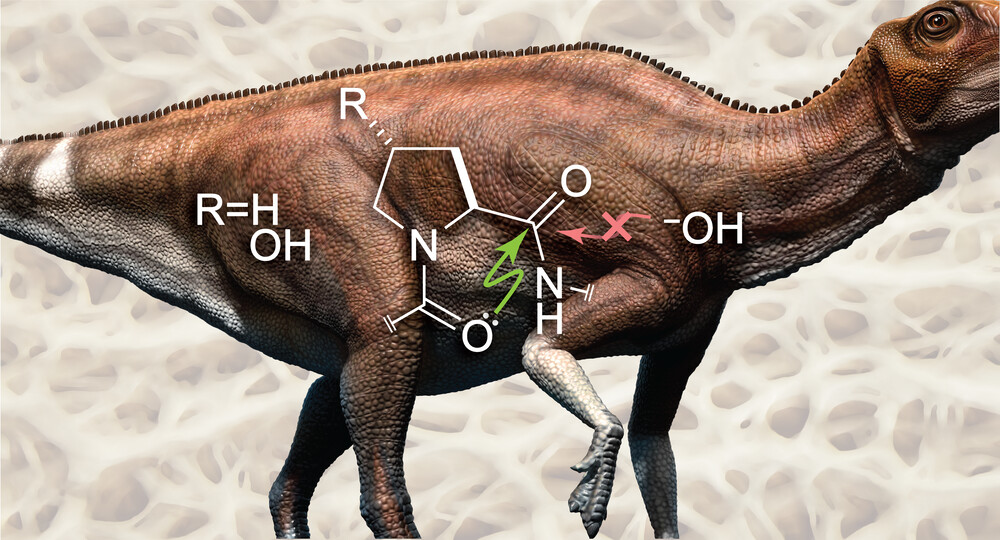Collagen is a mammal’s favorite protein, more used in the body than any other. It seems dinosaurs appreciated it too, as traces have been found in some fossils, but only now have chemists worked out how the usually fragile molecule could survive for so long.
A few decades ago, collagen was most famous for being injected into people’s skin to make them look younger. It already had many other applications by then, such as being heated to make gelatin for sweets and jellies and as a casing for sausages. Long before that, collagen glues were in use at least 8,000 years ago. Today it is the trendy additive in a lot of foods, but it also makes up a substantial portion of our bodies.
We don’t expect to find collagen in fossils more than a few thousand years old, however, because it is held together by peptide bonds that get broken when wet. However, a few remarkable dinosaur fossils still have intact collagen, including one specimen of a Lufengosaurus dated to the early Jurassic, 195 million years ago.
That’s astonishing for a protein that at room temperature usually loses half its bonds every 500 years. New research attributes this survival to an application of the Pauli exclusion principle, which you may recall from high school chemistry.
In the normal course of events, water breaks collagen’s peptide bonds through hydrolysis, even when bacteria don’t get at it. Dry conditions can extend its lifespan – that glue sample came from the desert around the Dead Sea – but everywhere has wet periods since the Mesozoic.
Scientists from MIT sought to explain the collagen samples’ survival and found carbonyl group interactions appear to be responsible. “We provide evidence that that interaction prevents water from attacking the peptide bonds and cleaving them. That just flies in the face of what happens with a normal peptide bond,” senior author Professor Ron Raines said in a statement.

A dinosaur with a schematic of the carbonyl groups, showing the bonds between carbon atoms in some and oxygens in others that keep water out.
Image Credit: ACS Central Science CC-By-4.0
The crucial bonds within collagen are between carbon and nitrogen molecules in neighboring amino acids. Taking advantage of its capacity to form four bonds, the carbon atom allocates two to an oxygen atom to form a carbonyl group, leaving an electron free to bond.
What had not previously been recognized is when these carbonyl groups can bond to each other they make a water-resistant link. This is where Pauli’s principle comes in. Pauli realized atoms can’t have more than one electron with a particular spin in an orbital. The carbonyl-carbonyl bonds effectively max out the available orbitals, leaving nowhere for the electrons from water to get in to initiate breakdown.
Raines’ team produced two proteins with collagen-like composition in forms capable of turning into each other. They named one cis and the other trans (the terms were common in chemistry before being caught in a culture war). The cis form breaks down on exposure to water, but the collagen-like trans form resists, thanks to its filled orbitals.
“A peptide bond is either cis or trans, and we can change the cis to trans ratio. By doing that, we can mimic the natural state of collagen or create an unprotected peptide bond. And we saw that when it was unprotected, it was not long for the world,” Raines said.
For whatever reason the collagen in a 68-million-year-old T. rex and a 195-million-year-old Lufengosaurus (among others) must have been mostly trans, allowing it to survive until we could study it.
Similar bonds have been seen in other proteins, but in those cases, while the bonds may endure, the rest of the proteins get destroyed by hydrolysis. “Collagen is all triple helices, from one end to the other,” Raines says. “There’s no weak link, and that’s why I think it has survived.”
There’s a reason dinosaurs and mammals alike make such widespread use of collagen, both in our bones and in the ligaments that connect them, and in humans’ case, our skin. “Collagen is the scaffold that holds us together,” Raines said. “What makes the collagen protein so stable, and such a good choice for this scaffold, is that unlike most proteins, it’s fibrous.”
Moreover, our bones and ligaments are exposed to water-based liquids like blood. Without a way to resist hydrolysis, the more permanent parts of our bodies would need to be constantly rebuilt, so collagen plays a vital role in our longevity.
The study is open access in ACS Central Science.
Source Link: How Dinosaur Collagen Has Been Found To Survive For 195 million Years